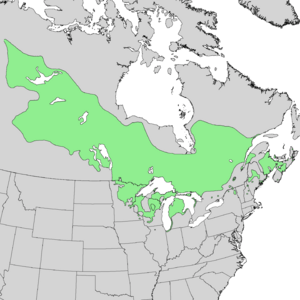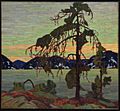Jack pine facts for kids
Quick facts for kids Jack pine |
|
|---|---|
 |
|
| Young jack pine | |
| Conservation status | |
| Scientific classification | |
| Genus: |
Pinus
|
| Species: |
banksiana
|
 |
|
| Native range | |
| Synonyms | |
|
|
The Jack Pine (Pinus banksiana) is a type of pine tree found in eastern North America. You can find it growing across Canada, from the Northwest Territories all the way to Nova Scotia. It also grows in the north-central and northeast parts of the United States, from Minnesota to Maine. Sometimes, people call it the grey pine or scrub pine.
In the western parts of its home, the Jack Pine can mix with a similar tree called the lodgepole pine. The scientific name banksiana comes from a famous English plant expert named Sir Joseph Banks.
Contents
What Does a Jack Pine Look Like?
Jack Pines usually grow to be about 9 to 22 meters (30 to 72 feet) tall. Some might be shorter, like shrubs, if they grow in tough spots. These trees often don't grow perfectly straight, which gives them a unique, uneven shape. They love to grow in sandy or rocky soil and can form large groups of just Jack Pines.
Needles and Cones
The leaves of the Jack Pine are like needles. They grow in pairs and are a bit twisted, with a yellowish-green color. Each needle is about 2 to 4 centimeters (1 to 1.5 inches) long.
The cones of the Jack Pine are usually about 5 centimeters (2 inches) long and have a curve at the tip. What's special about these cones is that they often point forward along the branch. This is a good way to tell them apart from other pines.
How Fire Helps Jack Pines Grow
Jack Pines are amazing because they are built to survive wildfires. Their cones stay tightly closed for many years. They only open up when they feel intense heat, like from a forest fire. When a fire happens, it clears out older trees and the heat makes the cones pop open. This releases their seeds onto the burnt ground, helping new Jack Pines grow. Sometimes, cones on lower branches can open from heat reflected off the ground, or even in very cold temperatures.
Jack Pine in Nature
Jack Pine forests are important homes for many animals and plants.
Home for Birds
The Kirtland's warbler is a small bird that used to be endangered. This bird relies on young Jack Pine forests in specific parts of Michigan for breeding. Older Jack Pine forests often have lots of blueberries growing on the ground beneath them.
Tree Health and Pests
Young Jack Pines can get a disease called sweet fern blister rust. This disease spreads from sweet fern plants to the trees. It can cause orange spots on the tree trunk and bumps on the lower branches. Luckily, older trees usually don't get this disease.
Another disease that can affect Jack Pines is scleroderris canker. This makes the needles turn yellow at the bottom. If a tree is sick for too long, it might even die.
Insects like the white pine weevil, jack pine sawfly, and jack pine budworm can also attack Jack Pine trees.
What Are Jack Pines Used For?
Like other pine trees, Jack Pines are used for their wood. Even though their wood can be a bit knotty and doesn't last super long against rot, it's still useful. People use Jack Pine wood to make pulpwood (for paper), fuel, decking for outdoor areas, and utility poles.
Images for kids
-
The Jack Pine (1917) by Tom Thomson, a famous painting of a Jack Pine in Algonquin Provincial Park
See also
 In Spanish: Pino de Banks para niños
In Spanish: Pino de Banks para niños








